Taxation Law Assignment: Income Tax and Capital Gains Tax
VerifiedAdded on 2020/05/16
|9
|2090
|62
Homework Assignment
AI Summary
This assignment analyzes various aspects of taxation law, focusing on income tax liability and capital gains tax. It examines the assessable income of individuals, including cash receipts, reimbursements, and scholarship income, as well as allowable deductions such as salaries and other business expenses. The document explores the tax implications of non-transferable vouchers, gifts, and insurance payouts. Furthermore, it delves into capital gains tax, particularly concerning the sale of business assets and restrictive covenants. The assignment also covers the tax treatment of insurance payments related to business assets and the classification of gifts as assessable income. The analysis is supported by references to relevant legislation and case law, providing a comprehensive overview of taxation principles and their practical application.
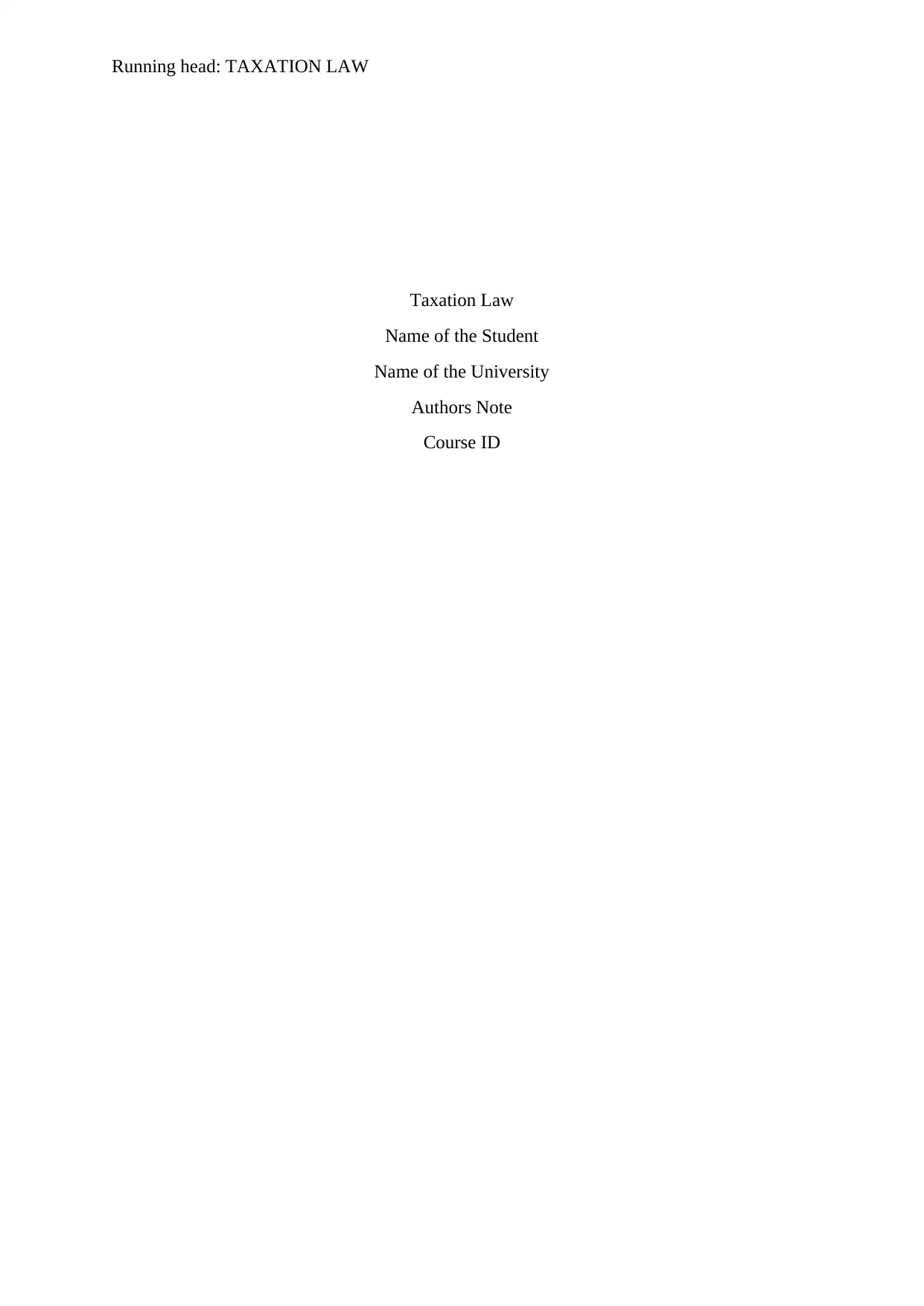
Running head: TAXATION LAW
Taxation Law
Name of the Student
Name of the University
Authors Note
Course ID
Taxation Law
Name of the Student
Name of the University
Authors Note
Course ID
Paraphrase This Document
Need a fresh take? Get an instant paraphrase of this document with our AI Paraphraser
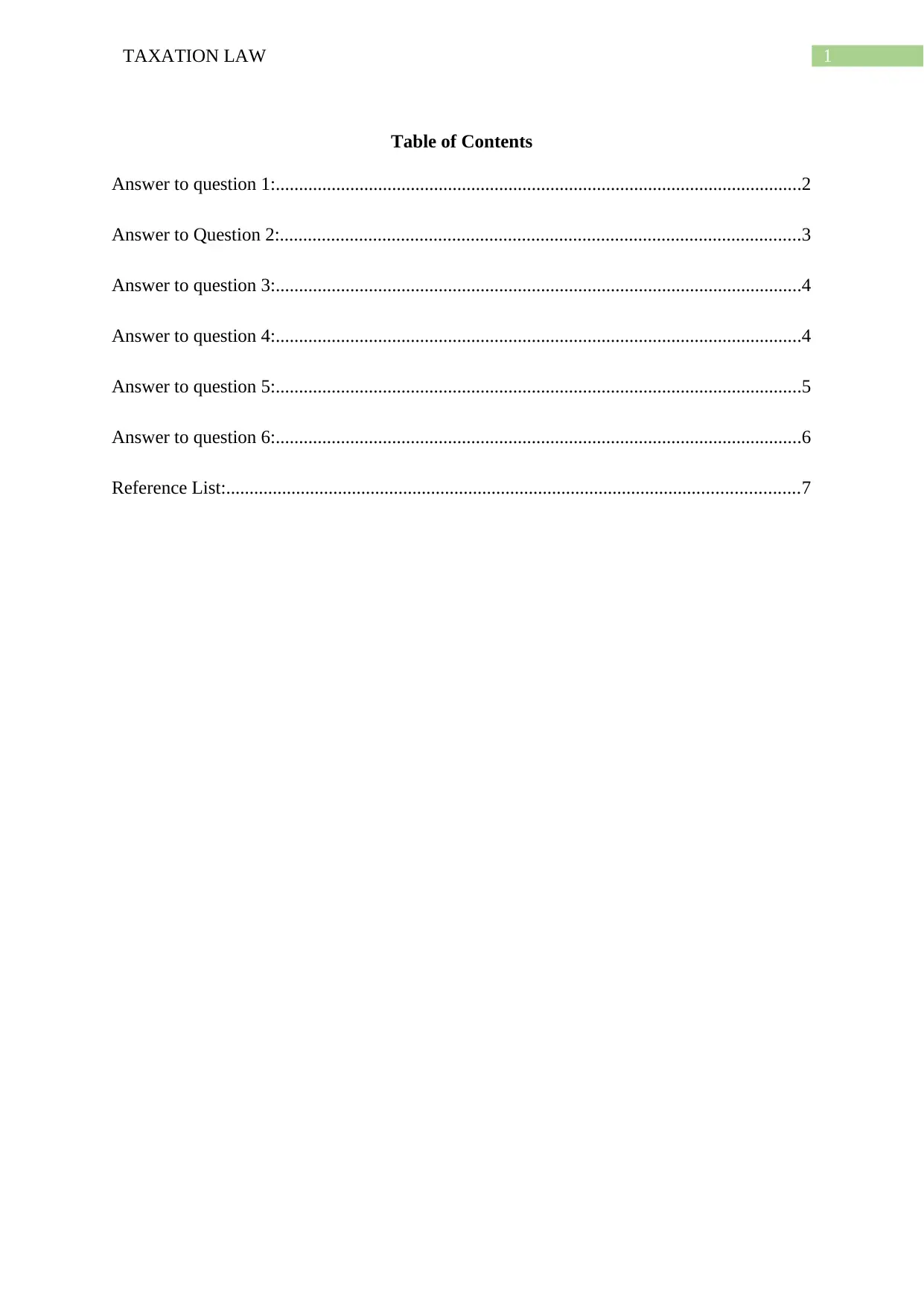
1TAXATION LAW
Table of Contents
Answer to question 1:.................................................................................................................2
Answer to Question 2:................................................................................................................3
Answer to question 3:.................................................................................................................4
Answer to question 4:.................................................................................................................4
Answer to question 5:.................................................................................................................5
Answer to question 6:.................................................................................................................6
Reference List:...........................................................................................................................7
Table of Contents
Answer to question 1:.................................................................................................................2
Answer to Question 2:................................................................................................................3
Answer to question 3:.................................................................................................................4
Answer to question 4:.................................................................................................................4
Answer to question 5:.................................................................................................................5
Answer to question 6:.................................................................................................................6
Reference List:...........................................................................................................................7
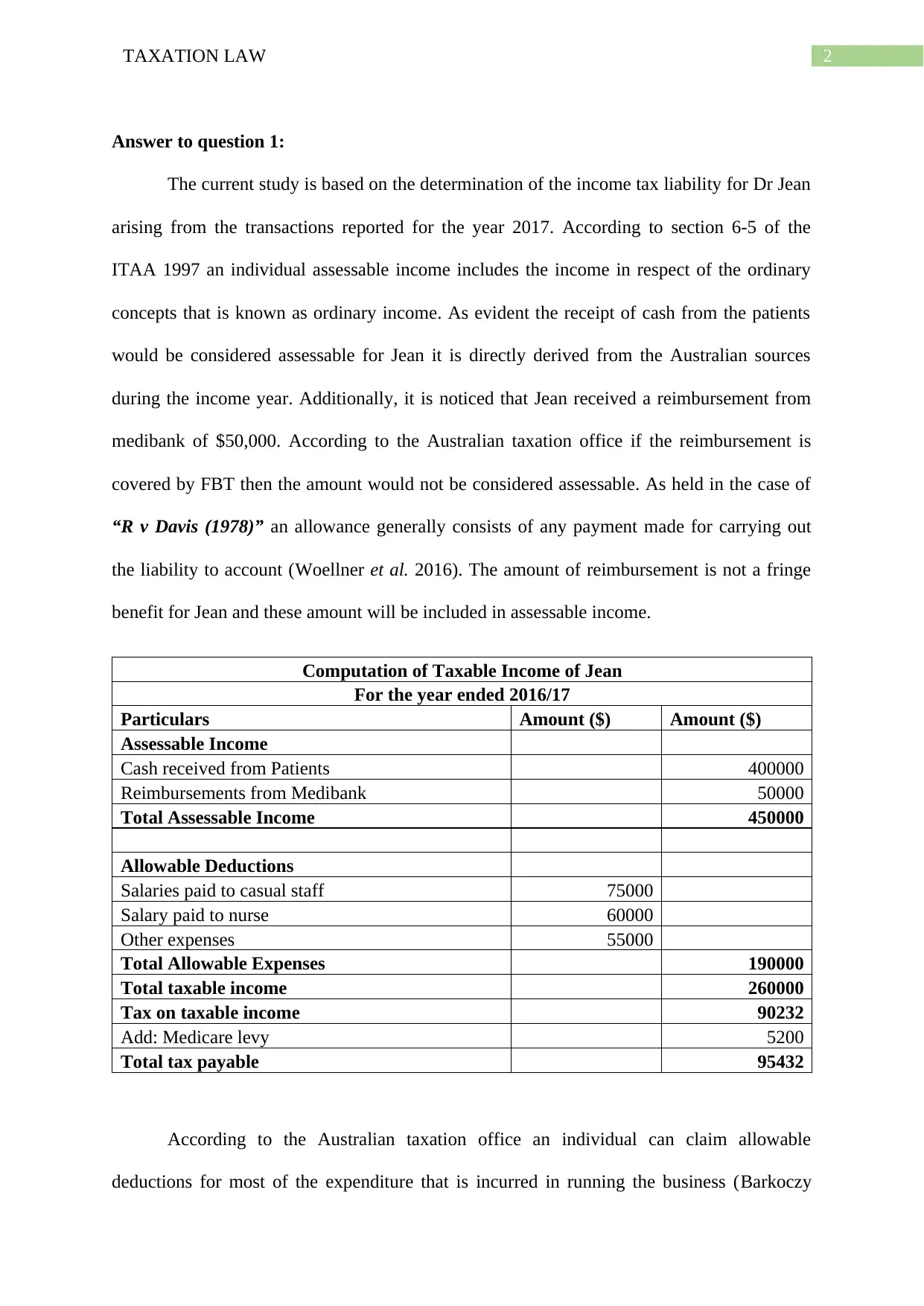
2TAXATION LAW
Answer to question 1:
The current study is based on the determination of the income tax liability for Dr Jean
arising from the transactions reported for the year 2017. According to section 6-5 of the
ITAA 1997 an individual assessable income includes the income in respect of the ordinary
concepts that is known as ordinary income. As evident the receipt of cash from the patients
would be considered assessable for Jean it is directly derived from the Australian sources
during the income year. Additionally, it is noticed that Jean received a reimbursement from
medibank of $50,000. According to the Australian taxation office if the reimbursement is
covered by FBT then the amount would not be considered assessable. As held in the case of
“R v Davis (1978)” an allowance generally consists of any payment made for carrying out
the liability to account (Woellner et al. 2016). The amount of reimbursement is not a fringe
benefit for Jean and these amount will be included in assessable income.
Computation of Taxable Income of Jean
For the year ended 2016/17
Particulars Amount ($) Amount ($)
Assessable Income
Cash received from Patients 400000
Reimbursements from Medibank 50000
Total Assessable Income 450000
Allowable Deductions
Salaries paid to casual staff 75000
Salary paid to nurse 60000
Other expenses 55000
Total Allowable Expenses 190000
Total taxable income 260000
Tax on taxable income 90232
Add: Medicare levy 5200
Total tax payable 95432
According to the Australian taxation office an individual can claim allowable
deductions for most of the expenditure that is incurred in running the business (Barkoczy
Answer to question 1:
The current study is based on the determination of the income tax liability for Dr Jean
arising from the transactions reported for the year 2017. According to section 6-5 of the
ITAA 1997 an individual assessable income includes the income in respect of the ordinary
concepts that is known as ordinary income. As evident the receipt of cash from the patients
would be considered assessable for Jean it is directly derived from the Australian sources
during the income year. Additionally, it is noticed that Jean received a reimbursement from
medibank of $50,000. According to the Australian taxation office if the reimbursement is
covered by FBT then the amount would not be considered assessable. As held in the case of
“R v Davis (1978)” an allowance generally consists of any payment made for carrying out
the liability to account (Woellner et al. 2016). The amount of reimbursement is not a fringe
benefit for Jean and these amount will be included in assessable income.
Computation of Taxable Income of Jean
For the year ended 2016/17
Particulars Amount ($) Amount ($)
Assessable Income
Cash received from Patients 400000
Reimbursements from Medibank 50000
Total Assessable Income 450000
Allowable Deductions
Salaries paid to casual staff 75000
Salary paid to nurse 60000
Other expenses 55000
Total Allowable Expenses 190000
Total taxable income 260000
Tax on taxable income 90232
Add: Medicare levy 5200
Total tax payable 95432
According to the Australian taxation office an individual can claim allowable
deductions for most of the expenditure that is incurred in running the business (Barkoczy
⊘ This is a preview!⊘
Do you want full access?
Subscribe today to unlock all pages.

Trusted by 1+ million students worldwide
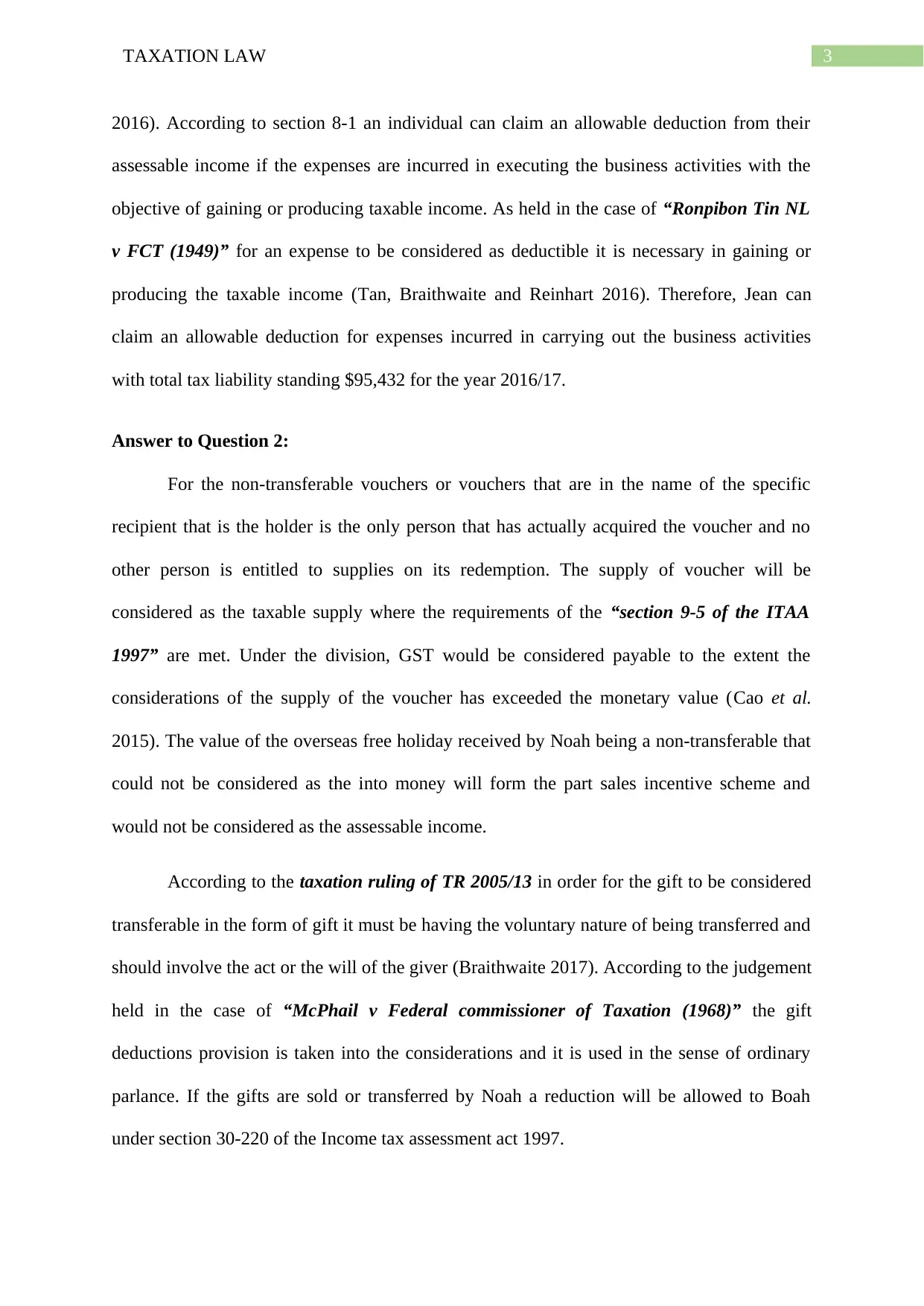
3TAXATION LAW
2016). According to section 8-1 an individual can claim an allowable deduction from their
assessable income if the expenses are incurred in executing the business activities with the
objective of gaining or producing taxable income. As held in the case of “Ronpibon Tin NL
v FCT (1949)” for an expense to be considered as deductible it is necessary in gaining or
producing the taxable income (Tan, Braithwaite and Reinhart 2016). Therefore, Jean can
claim an allowable deduction for expenses incurred in carrying out the business activities
with total tax liability standing $95,432 for the year 2016/17.
Answer to Question 2:
For the non-transferable vouchers or vouchers that are in the name of the specific
recipient that is the holder is the only person that has actually acquired the voucher and no
other person is entitled to supplies on its redemption. The supply of voucher will be
considered as the taxable supply where the requirements of the “section 9-5 of the ITAA
1997” are met. Under the division, GST would be considered payable to the extent the
considerations of the supply of the voucher has exceeded the monetary value (Cao et al.
2015). The value of the overseas free holiday received by Noah being a non-transferable that
could not be considered as the into money will form the part sales incentive scheme and
would not be considered as the assessable income.
According to the taxation ruling of TR 2005/13 in order for the gift to be considered
transferable in the form of gift it must be having the voluntary nature of being transferred and
should involve the act or the will of the giver (Braithwaite 2017). According to the judgement
held in the case of “McPhail v Federal commissioner of Taxation (1968)” the gift
deductions provision is taken into the considerations and it is used in the sense of ordinary
parlance. If the gifts are sold or transferred by Noah a reduction will be allowed to Boah
under section 30-220 of the Income tax assessment act 1997.
2016). According to section 8-1 an individual can claim an allowable deduction from their
assessable income if the expenses are incurred in executing the business activities with the
objective of gaining or producing taxable income. As held in the case of “Ronpibon Tin NL
v FCT (1949)” for an expense to be considered as deductible it is necessary in gaining or
producing the taxable income (Tan, Braithwaite and Reinhart 2016). Therefore, Jean can
claim an allowable deduction for expenses incurred in carrying out the business activities
with total tax liability standing $95,432 for the year 2016/17.
Answer to Question 2:
For the non-transferable vouchers or vouchers that are in the name of the specific
recipient that is the holder is the only person that has actually acquired the voucher and no
other person is entitled to supplies on its redemption. The supply of voucher will be
considered as the taxable supply where the requirements of the “section 9-5 of the ITAA
1997” are met. Under the division, GST would be considered payable to the extent the
considerations of the supply of the voucher has exceeded the monetary value (Cao et al.
2015). The value of the overseas free holiday received by Noah being a non-transferable that
could not be considered as the into money will form the part sales incentive scheme and
would not be considered as the assessable income.
According to the taxation ruling of TR 2005/13 in order for the gift to be considered
transferable in the form of gift it must be having the voluntary nature of being transferred and
should involve the act or the will of the giver (Braithwaite 2017). According to the judgement
held in the case of “McPhail v Federal commissioner of Taxation (1968)” the gift
deductions provision is taken into the considerations and it is used in the sense of ordinary
parlance. If the gifts are sold or transferred by Noah a reduction will be allowed to Boah
under section 30-220 of the Income tax assessment act 1997.
Paraphrase This Document
Need a fresh take? Get an instant paraphrase of this document with our AI Paraphraser
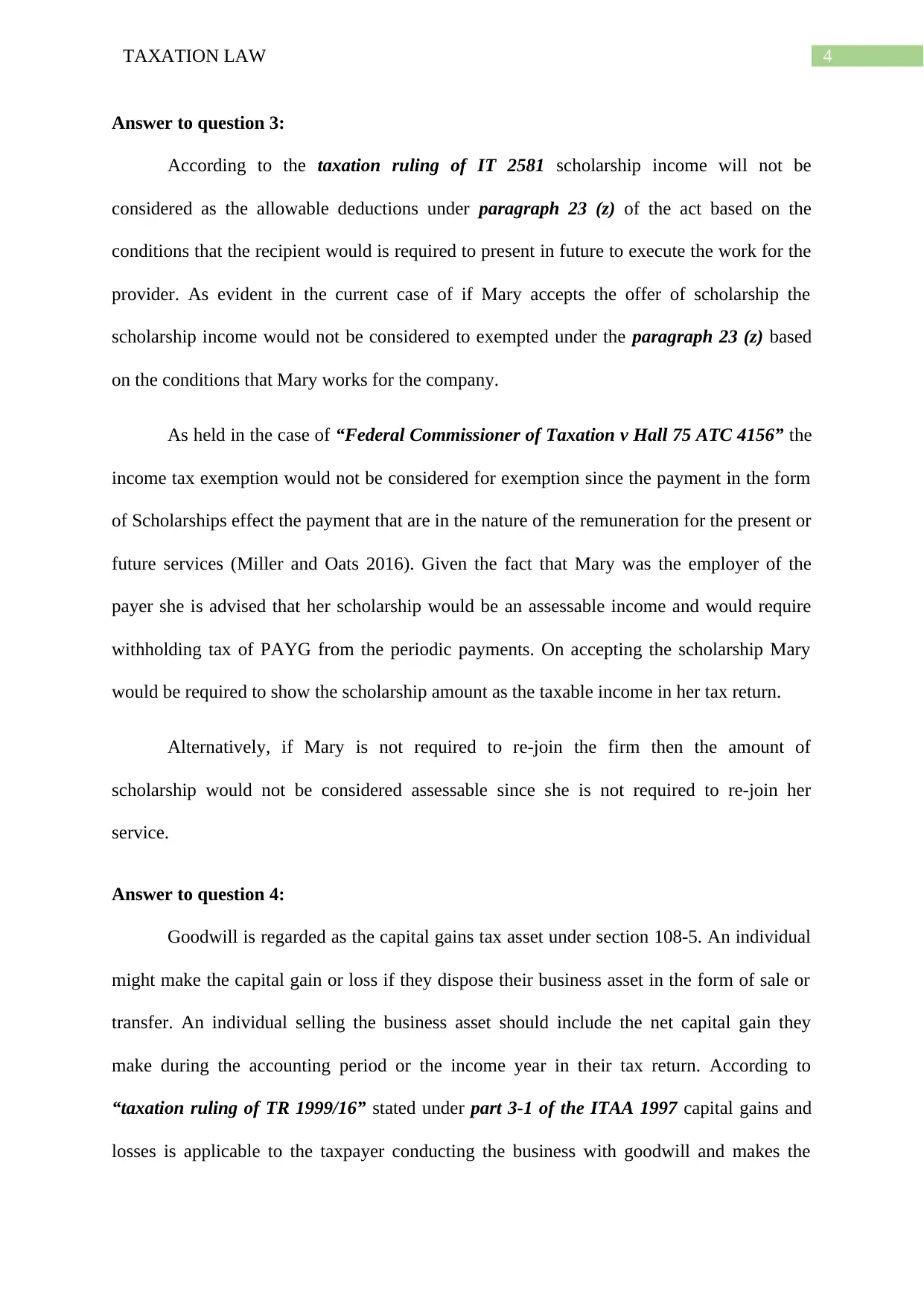
4TAXATION LAW
Answer to question 3:
According to the taxation ruling of IT 2581 scholarship income will not be
considered as the allowable deductions under paragraph 23 (z) of the act based on the
conditions that the recipient would is required to present in future to execute the work for the
provider. As evident in the current case of if Mary accepts the offer of scholarship the
scholarship income would not be considered to exempted under the paragraph 23 (z) based
on the conditions that Mary works for the company.
As held in the case of “Federal Commissioner of Taxation v Hall 75 ATC 4156” the
income tax exemption would not be considered for exemption since the payment in the form
of Scholarships effect the payment that are in the nature of the remuneration for the present or
future services (Miller and Oats 2016). Given the fact that Mary was the employer of the
payer she is advised that her scholarship would be an assessable income and would require
withholding tax of PAYG from the periodic payments. On accepting the scholarship Mary
would be required to show the scholarship amount as the taxable income in her tax return.
Alternatively, if Mary is not required to re-join the firm then the amount of
scholarship would not be considered assessable since she is not required to re-join her
service.
Answer to question 4:
Goodwill is regarded as the capital gains tax asset under section 108-5. An individual
might make the capital gain or loss if they dispose their business asset in the form of sale or
transfer. An individual selling the business asset should include the net capital gain they
make during the accounting period or the income year in their tax return. According to
“taxation ruling of TR 1999/16” stated under part 3-1 of the ITAA 1997 capital gains and
losses is applicable to the taxpayer conducting the business with goodwill and makes the
Answer to question 3:
According to the taxation ruling of IT 2581 scholarship income will not be
considered as the allowable deductions under paragraph 23 (z) of the act based on the
conditions that the recipient would is required to present in future to execute the work for the
provider. As evident in the current case of if Mary accepts the offer of scholarship the
scholarship income would not be considered to exempted under the paragraph 23 (z) based
on the conditions that Mary works for the company.
As held in the case of “Federal Commissioner of Taxation v Hall 75 ATC 4156” the
income tax exemption would not be considered for exemption since the payment in the form
of Scholarships effect the payment that are in the nature of the remuneration for the present or
future services (Miller and Oats 2016). Given the fact that Mary was the employer of the
payer she is advised that her scholarship would be an assessable income and would require
withholding tax of PAYG from the periodic payments. On accepting the scholarship Mary
would be required to show the scholarship amount as the taxable income in her tax return.
Alternatively, if Mary is not required to re-join the firm then the amount of
scholarship would not be considered assessable since she is not required to re-join her
service.
Answer to question 4:
Goodwill is regarded as the capital gains tax asset under section 108-5. An individual
might make the capital gain or loss if they dispose their business asset in the form of sale or
transfer. An individual selling the business asset should include the net capital gain they
make during the accounting period or the income year in their tax return. According to
“taxation ruling of TR 1999/16” stated under part 3-1 of the ITAA 1997 capital gains and
losses is applicable to the taxpayer conducting the business with goodwill and makes the
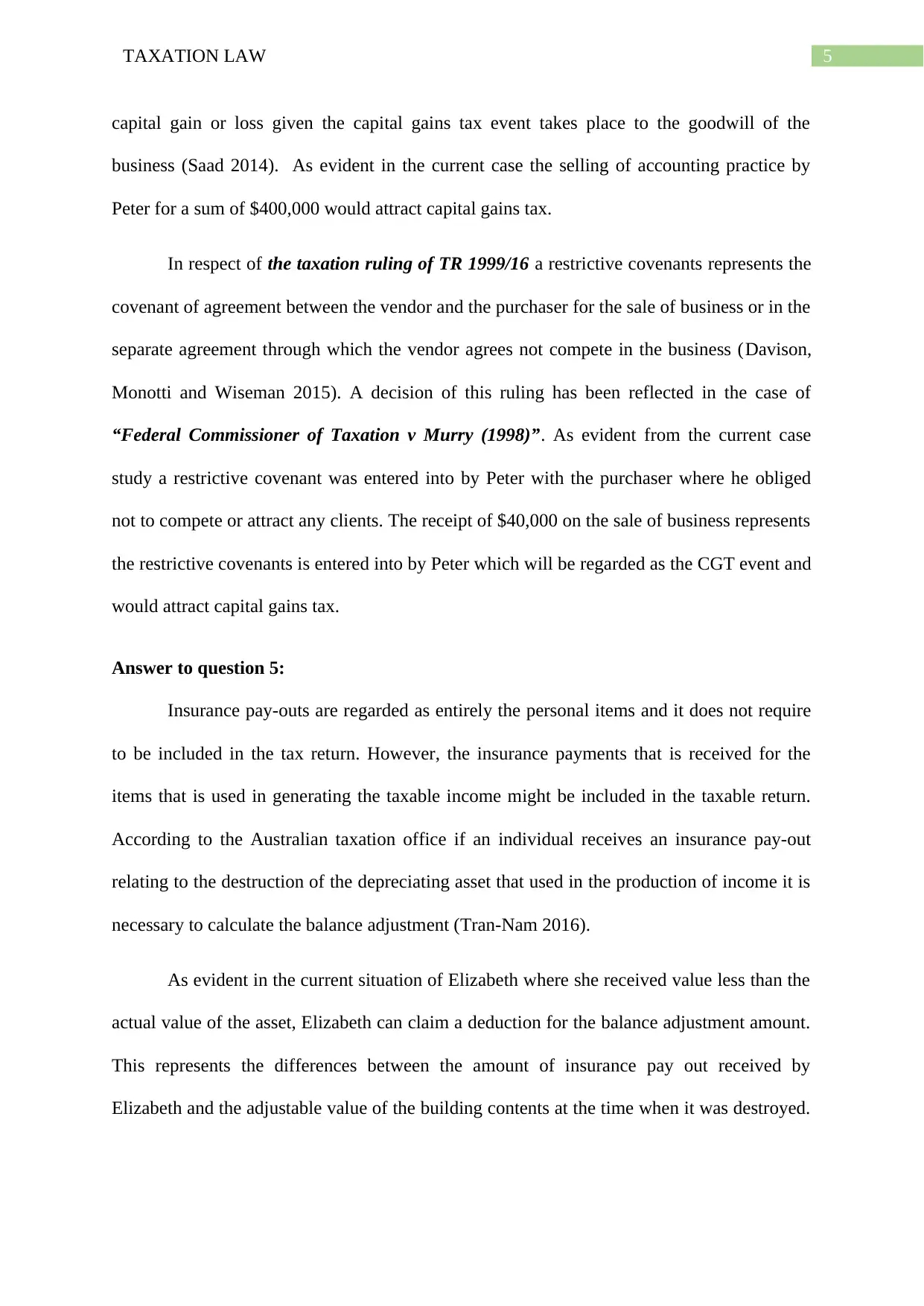
5TAXATION LAW
capital gain or loss given the capital gains tax event takes place to the goodwill of the
business (Saad 2014). As evident in the current case the selling of accounting practice by
Peter for a sum of $400,000 would attract capital gains tax.
In respect of the taxation ruling of TR 1999/16 a restrictive covenants represents the
covenant of agreement between the vendor and the purchaser for the sale of business or in the
separate agreement through which the vendor agrees not compete in the business (Davison,
Monotti and Wiseman 2015). A decision of this ruling has been reflected in the case of
“Federal Commissioner of Taxation v Murry (1998)”. As evident from the current case
study a restrictive covenant was entered into by Peter with the purchaser where he obliged
not to compete or attract any clients. The receipt of $40,000 on the sale of business represents
the restrictive covenants is entered into by Peter which will be regarded as the CGT event and
would attract capital gains tax.
Answer to question 5:
Insurance pay-outs are regarded as entirely the personal items and it does not require
to be included in the tax return. However, the insurance payments that is received for the
items that is used in generating the taxable income might be included in the taxable return.
According to the Australian taxation office if an individual receives an insurance pay-out
relating to the destruction of the depreciating asset that used in the production of income it is
necessary to calculate the balance adjustment (Tran-Nam 2016).
As evident in the current situation of Elizabeth where she received value less than the
actual value of the asset, Elizabeth can claim a deduction for the balance adjustment amount.
This represents the differences between the amount of insurance pay out received by
Elizabeth and the adjustable value of the building contents at the time when it was destroyed.
capital gain or loss given the capital gains tax event takes place to the goodwill of the
business (Saad 2014). As evident in the current case the selling of accounting practice by
Peter for a sum of $400,000 would attract capital gains tax.
In respect of the taxation ruling of TR 1999/16 a restrictive covenants represents the
covenant of agreement between the vendor and the purchaser for the sale of business or in the
separate agreement through which the vendor agrees not compete in the business (Davison,
Monotti and Wiseman 2015). A decision of this ruling has been reflected in the case of
“Federal Commissioner of Taxation v Murry (1998)”. As evident from the current case
study a restrictive covenant was entered into by Peter with the purchaser where he obliged
not to compete or attract any clients. The receipt of $40,000 on the sale of business represents
the restrictive covenants is entered into by Peter which will be regarded as the CGT event and
would attract capital gains tax.
Answer to question 5:
Insurance pay-outs are regarded as entirely the personal items and it does not require
to be included in the tax return. However, the insurance payments that is received for the
items that is used in generating the taxable income might be included in the taxable return.
According to the Australian taxation office if an individual receives an insurance pay-out
relating to the destruction of the depreciating asset that used in the production of income it is
necessary to calculate the balance adjustment (Tran-Nam 2016).
As evident in the current situation of Elizabeth where she received value less than the
actual value of the asset, Elizabeth can claim a deduction for the balance adjustment amount.
This represents the differences between the amount of insurance pay out received by
Elizabeth and the adjustable value of the building contents at the time when it was destroyed.
⊘ This is a preview!⊘
Do you want full access?
Subscribe today to unlock all pages.

Trusted by 1+ million students worldwide
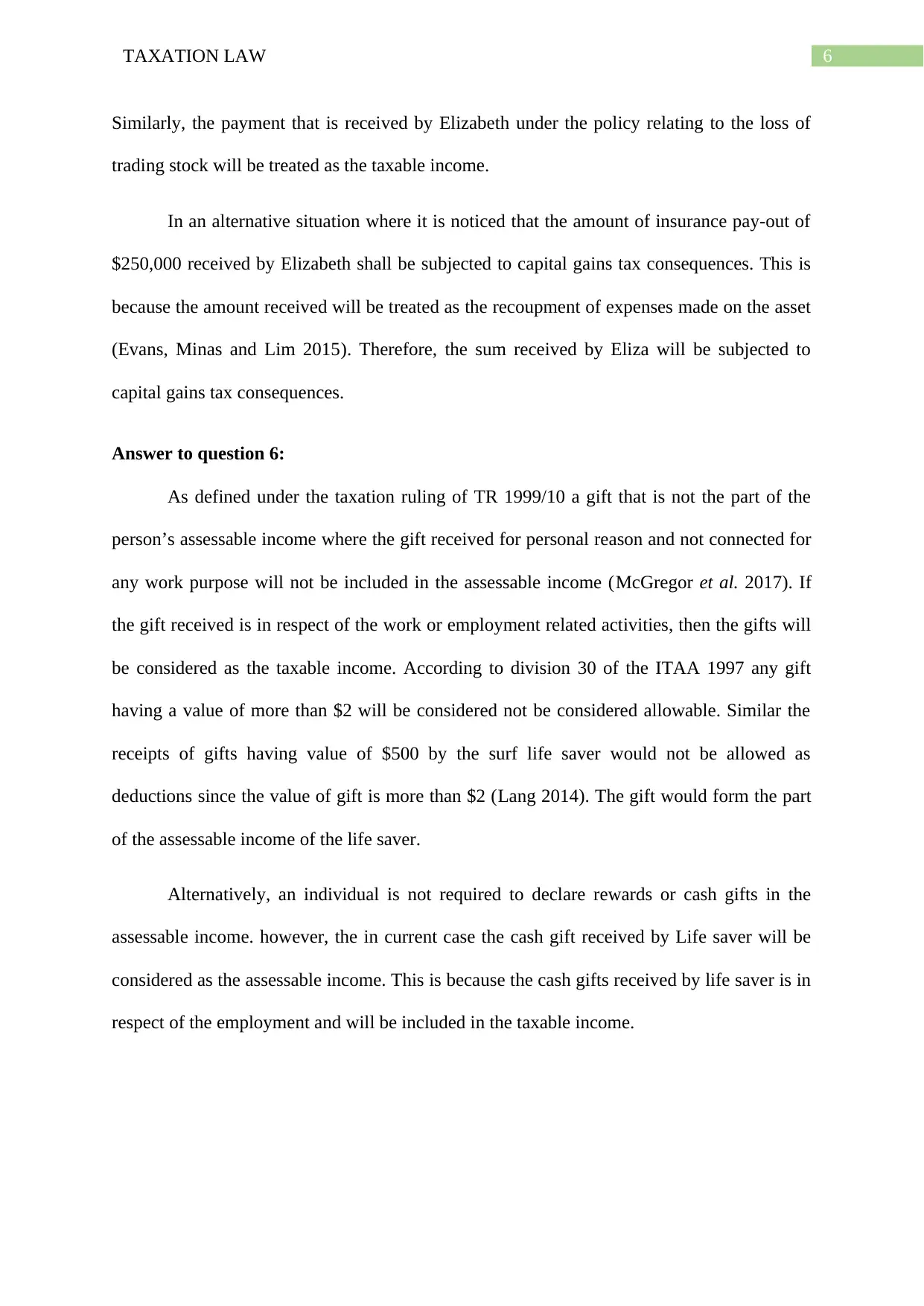
6TAXATION LAW
Similarly, the payment that is received by Elizabeth under the policy relating to the loss of
trading stock will be treated as the taxable income.
In an alternative situation where it is noticed that the amount of insurance pay-out of
$250,000 received by Elizabeth shall be subjected to capital gains tax consequences. This is
because the amount received will be treated as the recoupment of expenses made on the asset
(Evans, Minas and Lim 2015). Therefore, the sum received by Eliza will be subjected to
capital gains tax consequences.
Answer to question 6:
As defined under the taxation ruling of TR 1999/10 a gift that is not the part of the
person’s assessable income where the gift received for personal reason and not connected for
any work purpose will not be included in the assessable income (McGregor et al. 2017). If
the gift received is in respect of the work or employment related activities, then the gifts will
be considered as the taxable income. According to division 30 of the ITAA 1997 any gift
having a value of more than $2 will be considered not be considered allowable. Similar the
receipts of gifts having value of $500 by the surf life saver would not be allowed as
deductions since the value of gift is more than $2 (Lang 2014). The gift would form the part
of the assessable income of the life saver.
Alternatively, an individual is not required to declare rewards or cash gifts in the
assessable income. however, the in current case the cash gift received by Life saver will be
considered as the assessable income. This is because the cash gifts received by life saver is in
respect of the employment and will be included in the taxable income.
Similarly, the payment that is received by Elizabeth under the policy relating to the loss of
trading stock will be treated as the taxable income.
In an alternative situation where it is noticed that the amount of insurance pay-out of
$250,000 received by Elizabeth shall be subjected to capital gains tax consequences. This is
because the amount received will be treated as the recoupment of expenses made on the asset
(Evans, Minas and Lim 2015). Therefore, the sum received by Eliza will be subjected to
capital gains tax consequences.
Answer to question 6:
As defined under the taxation ruling of TR 1999/10 a gift that is not the part of the
person’s assessable income where the gift received for personal reason and not connected for
any work purpose will not be included in the assessable income (McGregor et al. 2017). If
the gift received is in respect of the work or employment related activities, then the gifts will
be considered as the taxable income. According to division 30 of the ITAA 1997 any gift
having a value of more than $2 will be considered not be considered allowable. Similar the
receipts of gifts having value of $500 by the surf life saver would not be allowed as
deductions since the value of gift is more than $2 (Lang 2014). The gift would form the part
of the assessable income of the life saver.
Alternatively, an individual is not required to declare rewards or cash gifts in the
assessable income. however, the in current case the cash gift received by Life saver will be
considered as the assessable income. This is because the cash gifts received by life saver is in
respect of the employment and will be included in the taxable income.
Paraphrase This Document
Need a fresh take? Get an instant paraphrase of this document with our AI Paraphraser
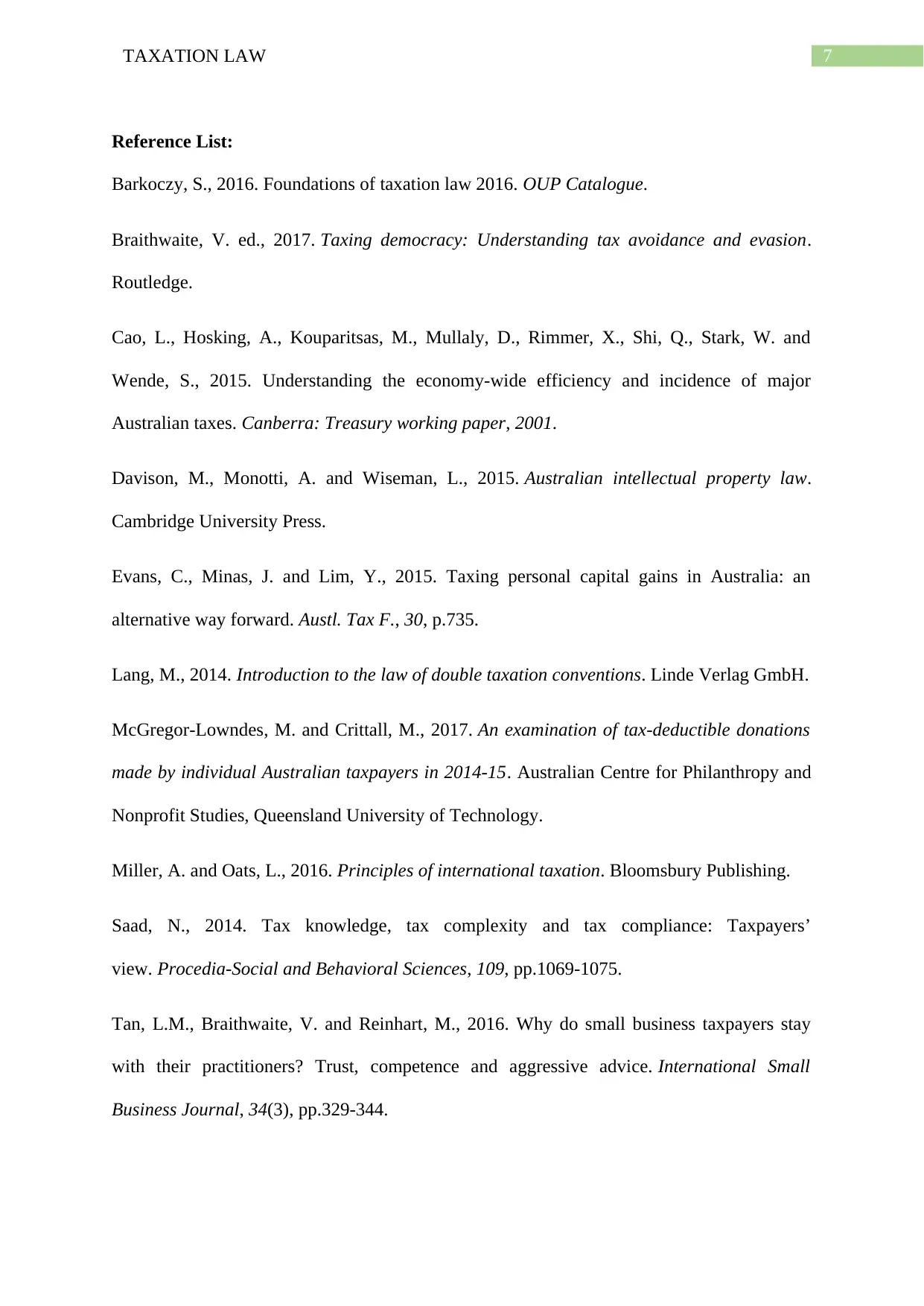
7TAXATION LAW
Reference List:
Barkoczy, S., 2016. Foundations of taxation law 2016. OUP Catalogue.
Braithwaite, V. ed., 2017. Taxing democracy: Understanding tax avoidance and evasion.
Routledge.
Cao, L., Hosking, A., Kouparitsas, M., Mullaly, D., Rimmer, X., Shi, Q., Stark, W. and
Wende, S., 2015. Understanding the economy-wide efficiency and incidence of major
Australian taxes. Canberra: Treasury working paper, 2001.
Davison, M., Monotti, A. and Wiseman, L., 2015. Australian intellectual property law.
Cambridge University Press.
Evans, C., Minas, J. and Lim, Y., 2015. Taxing personal capital gains in Australia: an
alternative way forward. Austl. Tax F., 30, p.735.
Lang, M., 2014. Introduction to the law of double taxation conventions. Linde Verlag GmbH.
McGregor-Lowndes, M. and Crittall, M., 2017. An examination of tax-deductible donations
made by individual Australian taxpayers in 2014-15. Australian Centre for Philanthropy and
Nonprofit Studies, Queensland University of Technology.
Miller, A. and Oats, L., 2016. Principles of international taxation. Bloomsbury Publishing.
Saad, N., 2014. Tax knowledge, tax complexity and tax compliance: Taxpayers’
view. Procedia-Social and Behavioral Sciences, 109, pp.1069-1075.
Tan, L.M., Braithwaite, V. and Reinhart, M., 2016. Why do small business taxpayers stay
with their practitioners? Trust, competence and aggressive advice. International Small
Business Journal, 34(3), pp.329-344.
Reference List:
Barkoczy, S., 2016. Foundations of taxation law 2016. OUP Catalogue.
Braithwaite, V. ed., 2017. Taxing democracy: Understanding tax avoidance and evasion.
Routledge.
Cao, L., Hosking, A., Kouparitsas, M., Mullaly, D., Rimmer, X., Shi, Q., Stark, W. and
Wende, S., 2015. Understanding the economy-wide efficiency and incidence of major
Australian taxes. Canberra: Treasury working paper, 2001.
Davison, M., Monotti, A. and Wiseman, L., 2015. Australian intellectual property law.
Cambridge University Press.
Evans, C., Minas, J. and Lim, Y., 2015. Taxing personal capital gains in Australia: an
alternative way forward. Austl. Tax F., 30, p.735.
Lang, M., 2014. Introduction to the law of double taxation conventions. Linde Verlag GmbH.
McGregor-Lowndes, M. and Crittall, M., 2017. An examination of tax-deductible donations
made by individual Australian taxpayers in 2014-15. Australian Centre for Philanthropy and
Nonprofit Studies, Queensland University of Technology.
Miller, A. and Oats, L., 2016. Principles of international taxation. Bloomsbury Publishing.
Saad, N., 2014. Tax knowledge, tax complexity and tax compliance: Taxpayers’
view. Procedia-Social and Behavioral Sciences, 109, pp.1069-1075.
Tan, L.M., Braithwaite, V. and Reinhart, M., 2016. Why do small business taxpayers stay
with their practitioners? Trust, competence and aggressive advice. International Small
Business Journal, 34(3), pp.329-344.
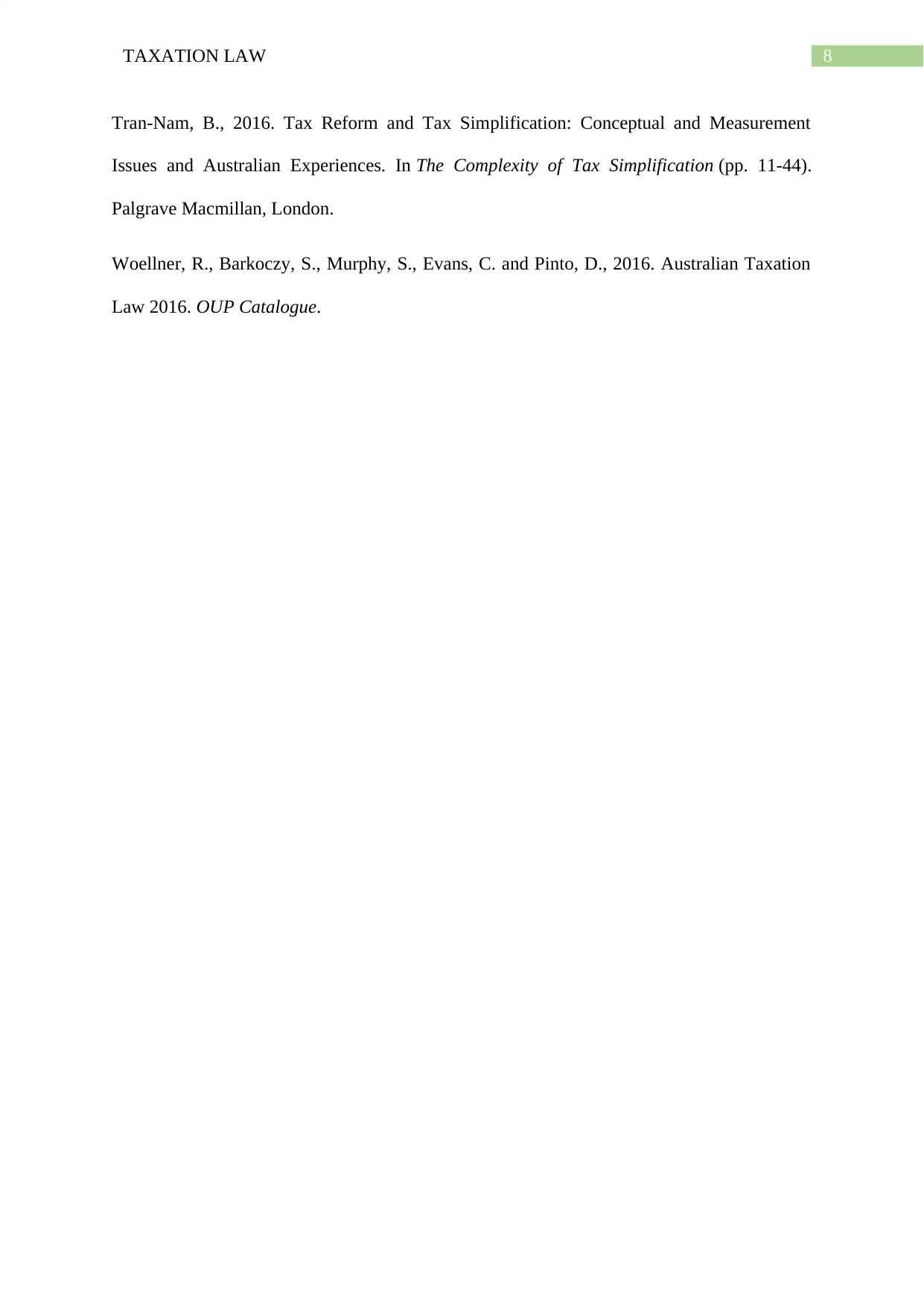
8TAXATION LAW
Tran-Nam, B., 2016. Tax Reform and Tax Simplification: Conceptual and Measurement
Issues and Australian Experiences. In The Complexity of Tax Simplification (pp. 11-44).
Palgrave Macmillan, London.
Woellner, R., Barkoczy, S., Murphy, S., Evans, C. and Pinto, D., 2016. Australian Taxation
Law 2016. OUP Catalogue.
Tran-Nam, B., 2016. Tax Reform and Tax Simplification: Conceptual and Measurement
Issues and Australian Experiences. In The Complexity of Tax Simplification (pp. 11-44).
Palgrave Macmillan, London.
Woellner, R., Barkoczy, S., Murphy, S., Evans, C. and Pinto, D., 2016. Australian Taxation
Law 2016. OUP Catalogue.
⊘ This is a preview!⊘
Do you want full access?
Subscribe today to unlock all pages.

Trusted by 1+ million students worldwide
1 out of 9
Related Documents
Your All-in-One AI-Powered Toolkit for Academic Success.
+13062052269
info@desklib.com
Available 24*7 on WhatsApp / Email
![[object Object]](/_next/static/media/star-bottom.7253800d.svg)
Unlock your academic potential
Copyright © 2020–2025 A2Z Services. All Rights Reserved. Developed and managed by ZUCOL.




